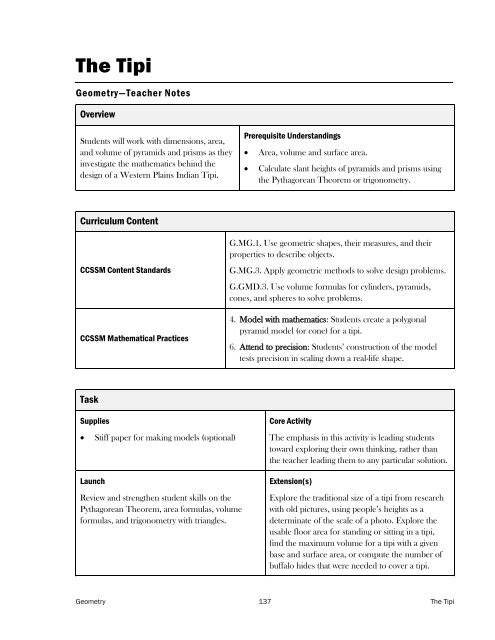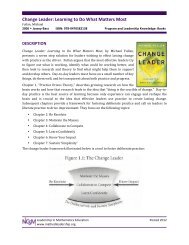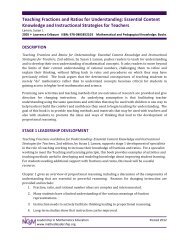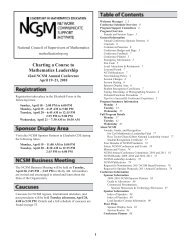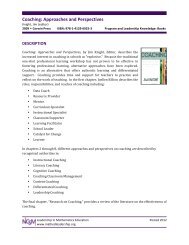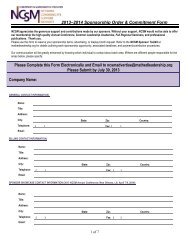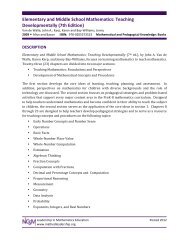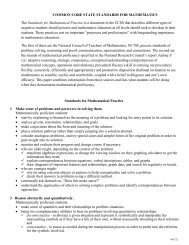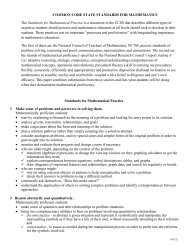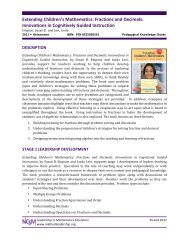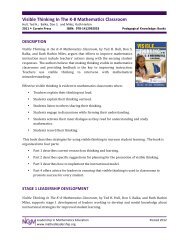You also want an ePaper? Increase the reach of your titles
YUMPU automatically turns print PDFs into web optimized ePapers that Google loves.
<strong>The</strong> <strong>Tipi</strong><strong>Geometry</strong>—Teacher NotesOverviewStudents will work with dimensions, area,and volume of pyramids and prisms as theyinvestigate the mathematics behind thedesign of a Western Plains Indian <strong>Tipi</strong>.Prerequisite UnderstandingsArea, volume and surface area.Calculate slant heights of pyramids and prisms usingthe Pythagorean <strong>The</strong>orem or trigonometry.Curriculum ContentCCSSM Content StandardsCCSSM Mathematical PracticesG.MG.1. Use geometric shapes, their measures, and theirproperties to describe objects.G.MG.3. Apply geometric methods to solve design problems.G.GMD.3. Use volume formulas for cylinders, pyramids,cones, and spheres to solve problems.4. Model with mathematics: Students create a polygonalpyramid model (or cone) for a tipi.6. Attend to precision: Students’ construction of the modeltests precision in scaling down a real-life shape.TaskSuppliesLaunchStiff paper for making models (optional)Review and strengthen student skills on thePythagorean <strong>The</strong>orem, area formulas, volumeformulas, and trigonometry with triangles.Core Activity<strong>The</strong> emphasis in this activity is leading studentstoward exploring their own thinking, rather thanthe teacher leading them to any particular solution.Extension(s)Explore the traditional size of a tipi from researchwith old pictures, using people’s heights as adeterminate of the scale of a photo. Explore theusable floor area for standing or sitting in a tipi,find the maximum volume for a tipi with a givenbase and surface area, or compute the number ofbuffalo hides that were needed to cover a tipi.<strong>Geometry</strong> 137 <strong>The</strong> <strong>Tipi</strong>
<strong>The</strong> <strong>Tipi</strong>LaunchUse geometric and trigonometric formulas to analyze the following geometric shape.1. Compare the slant height and the volume of a cone with a height of 20 cm and a diameter of the baseof 8 cm to the slant height and the volume of a square pyramid with a height of 20 cm and a basediagonal of 8 cm.2. Find the altitude, missing side length, missing angles’ measurements, and area of the triangle below.3. Describe how to find the surface area and volume of pyramids with a regular polygon as a base.<strong>Geometry</strong> 138 <strong>The</strong> <strong>Tipi</strong>
<strong>The</strong> <strong>Tipi</strong>ActivityA strong part of western American culture is the PlainsIndian <strong>Tipi</strong>. This structure could be as simple as a 3 polestructure (a tetrahedron shape) but usually was much moreelaborate, with 12 or more poles giving the structures a coneshaped appearance.Your task will be to create an engineering design and a scalemodel of a life-sized tipi. Provide specifications, and describethe processes you used to come up with the measurements.<strong>The</strong> life-sized tipi you will be modeling is a 12-pole tipi with aheight of 18 feet to the cross pole, and has a perimeter of 48feet (4 feet between poles).1. Prepare a detailed specification sheet. It should include the following:A title page with your name.A drawing of the area of the base of the tipi with measurements of lengths and areas.A drawing of the net (the cover of the tipi) with area calculations.<strong>The</strong> calculated volume of the tipi.A supplemental page where you outline the formulas and calculations you did to find theinformation above.2. Create a scale model of the tipi.Make your model from any materials you wish.Make a title card to place with the model that includes its title, your name, and the scale of themodel.3. Decorate the cover with some traditional Plains Indian designs or geometric patterns.<strong>Geometry</strong> 139 <strong>The</strong> <strong>Tipi</strong>
<strong>The</strong> <strong>Tipi</strong>Results from the ClassroomThis task was tackled by a class that had just started the year withtrigonometry and had an easy fluency with formulas and angles.Fewer than 20% of the students chose the option of using acomputer program to build their models. One student’scomputer-generated scale model of a side of the <strong>Tipi</strong> (the base,one side, and a side view) is shown on the right.Most students chose to make all drawings and all calculations byhand on cm grid paper. <strong>The</strong> actual scale models turned in bymost students used a scale of 1cm = 2 ft. It was clear that the sizeof the paper and open discussions during the project design and building phase resulted in students sharingtheir ideas for scale with each other. Most scale models came out very close in size because of thissimilarity of scale. To get more variety in the final results, have students use different scales or vary theheights and number of poles.<strong>The</strong> project did result in someinteresting errors by students. Takethe list of formulas typed on onepaper (see right). This studentassumed the shape was just a coneand made some other basic errorssuch as the formula forcircumference and the slant surfacearea (1/2 of a circle?).<strong>The</strong> student work to the far right made extensive use ofthe Pythagorean <strong>The</strong>orem and did not rely ontrigonometric calculations for most angles in thedrawings.Many of the drawings looked like the one on the left. <strong>The</strong>y wereaccurate, neat, readable, and involved the correct scale. Labelingall angles in the drawings would help reinforce the applications oftrigonometry to this project.As a final note, the real tipis of the America Plains Indians wereactually made of animal skins and were stitched together inpatterns that could be adjusted as they were being built. Trial anderror along with experience certainly has a value!<strong>Geometry</strong> 140 <strong>The</strong> <strong>Tipi</strong>


